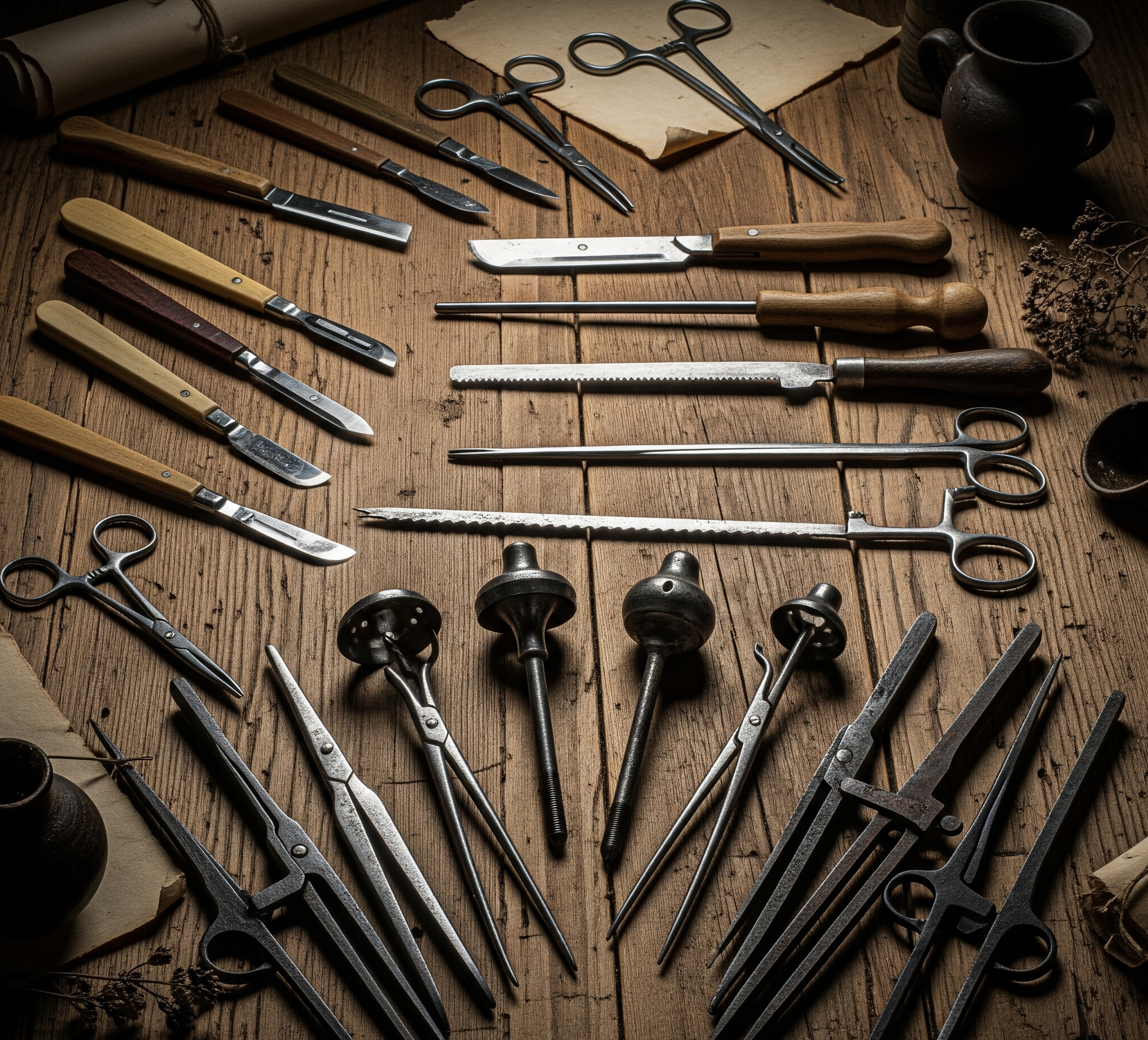When we think about surgery today, images of modern operating rooms, advanced surgical tools, and high-tech machines come to mind. But centuries ago, medicine looked very different. Long before the invention of anesthesia, antiseptics, and stainless steel scalpels, physicians and barber-surgeons in the Middle Ages were already performing complex procedures using simple yet ingenious devices. These tools, known as medieval surgical instruments, laid the foundation for modern surgery.
This article explores the fascinating history, types, and uses of medieval surgical instruments, highlighting how early innovations influenced today’s medical practices.
The Role of Surgery in Medieval Times
During the medieval era (roughly 5th to 15th century), medical knowledge was heavily influenced by ancient Greek and Roman texts, particularly the works of Hippocrates and Galen. Universities and monasteries preserved this knowledge, while traveling physicians and barber-surgeons adapted it to practical use.
Surgery was considered risky and often painful, as anesthesia was not yet developed. Herbal remedies, alcohol, or opium were sometimes used to dull pain, but most patients had to endure procedures fully conscious. Despite these challenges, surgical interventions were common, particularly during wars, plagues, and outbreaks.
Importance of Medieval Surgical Instruments
Medieval surgical instruments were crucial for procedures such as:
- Wound treatment for soldiers injured in battle.
- Amputations to prevent infections from spreading.
- Bloodletting, believed to balance bodily “humors.”
- Bone setting and treating fractures.
- Cauterization, used to stop bleeding.
These instruments reflected both the limitations and creativity of medieval medicine. While they may look crude by today’s standards, many were surprisingly effective.
Types of Medieval Surgical Instruments
Let’s take a closer look at the categories of surgical instruments used in the Middle Ages.
1. Cutting Instruments
These were used for incisions, amputations, and removal of diseased tissue.
- Scalpels and Knives: Small blades crafted from iron or bronze, used for cutting skin and tissues.
- Amputation Saws: Designed to remove infected or crushed limbs.
- Trephines: Circular saw-like tools used for drilling holes in the skull to relieve pressure (trepanation).
2. Grasping and Holding Instruments
These tools helped surgeons handle tissues and extract foreign objects.
- Forceps: Used for extracting arrows, stones, and teeth.
- Tongs: Crude versions of modern surgical clamps.
- Dental Extractors: Early pliers used for tooth removal.
3. Cauterization Tools
Used to stop bleeding and sterilize wounds.
- Hot Irons: Heated in fire and applied to wounds.
- Cautery Knives: Blades designed to both cut and burn tissue simultaneously.
4. Probing and Dilating Instruments
Used for examining wounds or body cavities.
- Probes: Thin rods to explore wound depth.
- Speculums: Primitive devices for examining the ear, nose, or vaginal cavity.
5. Bloodletting Instruments
Bloodletting was one of the most common medieval treatments.
- Lancets: Sharp blades for opening veins.
- Fleams: Multi-bladed instruments for controlled incisions.
- Leeching Tools: Devices to assist in applying leeches.
6. Bone and Joint Instruments
Surgeons frequently dealt with broken bones and fractures, especially during wars.
- Bone Saws: For amputations or cutting through bone.
- Elevators: Used to lift fractured bone fragments.
- Traction Devices: Crude splints and pulleys for bone alignment.
Materials Used in Medieval Instruments
Most medieval surgical instruments were made of:
- Iron or Steel: Durable and easy to sharpen, though prone to rust.
- Bronze: Resistant to corrosion but softer.
- Wood and Leather: Handles were often made from these for grip.
Unlike today’s sterile surgical steel, medieval instruments were difficult to keep clean, often leading to infections.
Risks and Challenges of Medieval Surgery
Surgery in the Middle Ages was highly dangerous. Major risks included:
- Infection: Without sterilization, wounds often became septic.
- Pain: Lack of anesthesia made surgery unbearable.
- Bleeding: Many patients died from blood loss.
- Superstition: Medical knowledge was mixed with religious and magical beliefs.
Despite these dangers, many lives were saved, and surgical techniques gradually improved.
Influence of Medieval Instruments on Modern Surgery
While crude, many medieval instruments inspired modern surgical tools:
- Trephines evolved into neurosurgical drills.
- Forceps developed into precise extraction tools.
- Speculums became refined for gynecological and ENT use.
- Cauterization devices influenced modern electrosurgery equipment.
Medieval medicine may appear primitive, but it served as the stepping stone for today’s sophisticated surgical practices.
Famous Medieval Surgeons
Several physicians of the Middle Ages advanced surgical knowledge through their writings and inventions:
- Albucasis (Al-Zahrawi): Known as the “Father of Modern Surgery,” he described over 200 surgical instruments in his book Kitab al-Tasrif.
- Guy de Chauliac: His Chirurgia Magna was a standard surgical text for centuries.
- Henri de Mondeville: Advocated for cleanliness in surgery.
Their contributions helped standardize surgical practice and influenced medical schools across Europe.
Preservation and Display of Medieval Surgical Instruments
Today, many original medieval surgical instruments are preserved in museums and historical collections, such as:
- The Wellcome Collection (London)
- The Science Museum (London)
- The Museum of the History of Medicine (Paris)
These artifacts provide valuable insight into the evolution of medicine and human ingenuity.
Conclusion
The story of medieval surgical instruments is both fascinating and sobering. Despite the absence of anesthesia, antibiotics, and sterilization, surgeons of the Middle Ages developed ingenious tools to treat wounds, perform amputations, and save lives. Their work laid the foundation for modern surgery, proving that human innovation thrives even under limited conditions.
By studying these instruments, we gain a deeper appreciation of how far medicine has come—and how much we owe to the courage and creativity of early surgeons.

